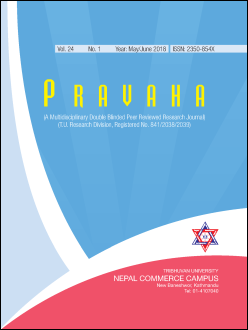Tourism Demand Analysis Using Probabilistic Travel Model: A Study In Pokhara
DOI:
https://doi.org/10.3126/pravaha.v24i1.20226Keywords:
Eco-tourism, Command area, Tourist attractions, Probabilistic travel model JEL codes, C22, E01, F43, L83Abstract
Tourism is now one of the largest industries in the world that has developed alongside the fascinating concept of eco-tourism. Nepal Tourism Policy 2009 identifies tourism sector as an important vehicle for economic and social development. Revenue from tourism sector is observed from foreign currency exchange made by tourists and tourism industries as proxy of income. According to Tourism Towards 2030, the number of international tourist arrivals worldwide is expected to increase by an average of 3.3% a year over the period 2010 to 2030. At the projected rate of growth, international tourist arrivals worldwide are expected to reach 1.4 billion by 2020, and 1.8 billion by the year 2030. Nepal aims to transform its tourism sector into one of the largest foreign exchange earners in 2016 by attracting 2.5 million high spending tourists. Tourism was ranked as the fifth largest source of foreign exchange earnings in 2012 and third largest in 2013 contributing 5.2 percent to total foreign earnings of the country. This study shows the tourism infrastructure as well as seasonal arrival of tourists in Nepal and to develop the probabilistic travel model on the basis of tourist perception which will help the tourism department for the further economic development of the area. R-Studio based on data from the sample period from 2008 to 2016. The formula presented in this study can be used by policy makers to calculate future foreign exchange earnings, employment, arrivals and prices related to tourism in Nepal.
Pravaha
Vol. 24, No. 1, 2018, Page: 58-63
Downloads
Downloads
Published
How to Cite
Issue
Section
License
© Nepal Commerce Campus, TU
Authors are required to transfer their copyright to the Nepal Commerce Campus, TU.




